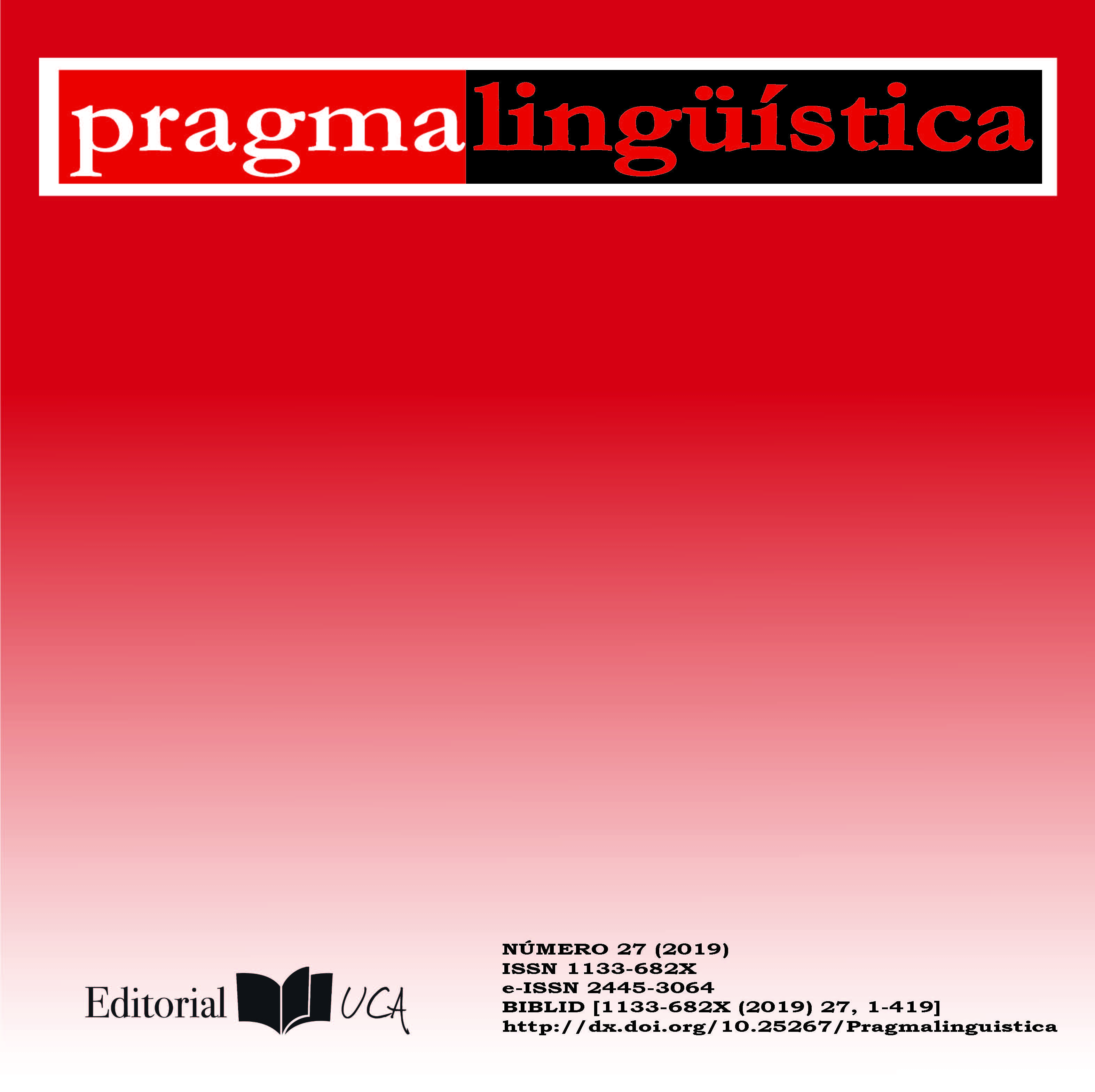The semantic profile of Spanish compounds: lexical compounds and appositive compounds

DOI
https://doi.org/10.25267/Pragmalinguistica.2019.i27.07Info
Abstract
In this paper I analyze and compare the semantic properties of N+N compounds, N+Adj compounds and V+N/N+V compounds. Different semantic aspects are dealt with, such as the relationship between the compound and the object to which it refers, the semantic relationships between constituents, and the predominant conceptual classes. The sum of all these aspects, when compared according to the compound class that manifests them, leads to the conclusion that both structural semantics and conceptual preferences determine the choice between compound patterns when a new compound word is to be created.
Keywords
Downloads
Supporting Agencies
How to Cite
License

This work is licensed under a Creative Commons Attribution-NonCommercial-NoDerivatives 4.0 International License.
References
ALONSO RAMOS, M. (2002): “Colocaciones y contorno de la definición lexicográfica”, Lingüística Española Actual, 24(1), pp. 63-96.
BAKER, M. (2003): Lexical categories. Verbs, nouns and adjectives, Cambridge: CUP.
BAUER, L. (2008): “Exocentric compounds”, Morphology, 18(1), pp. 151-174.
BUENAFUENTES DE LA MATA, C. (2007): Procesos de gramaticalización y lexicalización en la formación de compuestos en español, Barcelona: UAB.
BUSTOS GISBERT, E. (1986): La composición nominal en español, Salamanca: Universidad de Salamanca.
DÍAZ HORMIGO, M. T. (2012): “Consideraciones sobre la flexión de los compuestos sintagmáticos”, Felíu Arquiola, Martín García, J., Fábregas Alfaro, A., y Pazó, J. (coords.): Los limites de la Morfología. Estudios ofrecidos a Soledad Varela Ortega, Madrid: UAM, pp. 133-144.
DOWNING, P. (1977): “On the Creation and Use of English Compound Nouns”, Language, 53(4), pp. 810-842.
FÁBREGAS ALFARO, A. (2005): La definición de la categoría gramatical en una morfología orientada sintácticamente: nombres y adjetivos, Madrid: UAM.
FÁBREGAS ALFARO, A. (2006): “La relación entre morfología y sintaxis: compuestos de dos sustantivos y nombres de color”, Verba, 33, pp. 103-122.
GARCÍA LOZANO, F. (1978): “Los compuestos de sustantivo + adjetivo del tipo pelirrojo”, Iberorromania, 8, pp. 82-89.
GARCÍA PAGE, M. (2011): “Hombre clave, hombre rana, ¿un mismo fenómeno?”, Verba, 38, pp. 127-170.
GRUBER, J. (1965): Studies in Lexical Relations, Cambridge: MIT.
JACKENDOFF, R. (2016): “English NN compounds in Conceptual Semantic”, P. Ten Hacken (ed.): The Semantics of Compounding, Cambridge: CUP, pp. 15-38.
JIMÉNEZ RÍOS, E. (1999): “Aguafiestas, metepatas y otros compuestos nominales peculiares”, Estudios de Lingüística de la Universidad de Alicante, 13, 117-148.
KLINGEBIEL, K. (1989): Noun+Verb Compounding in Western Romance, Berkeley: University of California Press.
LANGACKER, R. (1995): “Possession and Possessive Constructions”, Taylor, J. y R. MacLaury (eds.): Language and the Cognitive Construal of the World, Berlin: Mouton, pp. 51-79.
LEES, R. (1960): The Grammar of English Nominalizations, The Hague, Mouton.
LIEBER, R. (1983): “Argument linking and compounds in English”, Linguistic inquiry, 14(2), pp. 251-285.
LIEBER, R. (2004): Morphology and Lexical Semantics, Cambridge, CUP.
LIEBER, R. (2016): “On the interplay of facts and theory: Revisiting synthetic compounds in English”, Siddiqi, D. y Harley H. (eds.): Morphological Metatheory, Amsterdam: John Benjamins, pp. 513-536.
LLOYD, P. (1968): Verb-Complement Compounds in Spanish, Tübingen: Niemeyer.
MONTORO DEL ARCO, E. (2008): “Relaciones entre Morfología y Fraseología: las formaciones nominales pluriverbales”, E. Montoro del Arco y Almela Rodríguez, R. (eds.), Neologismo y Morfología, Murcia: UM, pp. 121-147.
MOYNA, I. (2011): Compound words in Spanish: Theory and History, Amsterdam: John Benjamins.
PINTO, I., PAULIS, G. y PUTZU, I. (2002): “Sardinian adjectives with the NiA structure”, Lingue e Linguaggio, 11(1), pp. 49-70.
RAINER, F., y VARELA ORTEGA, S. (1992): “Compounding in Spanish”, Rivista di Linguistica, 4(1), 117-142.
SÁNCHEZ LÓPEZ, C. (2003): "La relación de posesión inalienable en los compuestos", Girón, J. L., Herrero, J., Iglesias, S. y A. Narbona (eds.): Estudios ofrecidos al profesor José Jesús de Bustos Tovar, pp. 157-169.
SCALISE, S., FÁBREGAS ALFARO, A. y FORZA, F. (2009): “Exocentricity in Compounding”, Gengo Kenkyu, 135, pp. 49-84.
VAL ÁLVARO, J. F. (1999): “La composición”, Bosque Muñoz, I. y Demonte Barreto, V. (dirs.): Gramática Descriptiva de la Lengua Española, Madrid: Espasa-Calpe, pp. 4757-4841.
VARELA ORTEGA, S. y FELÍU ARQUIOLA, E. (2003): “Internally motivated structural borrowing in Spanish morphology”, Kempchinsky, P. y Piñeros, C. (eds.): Theory, Practice and Acquisition, Sommerville, MA, Cascadilla: pp. 83-101.






